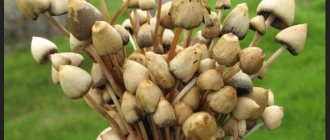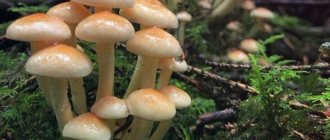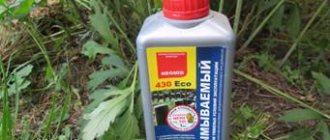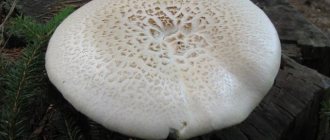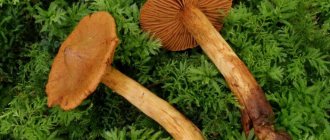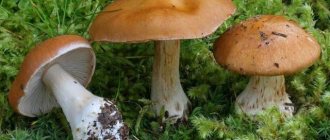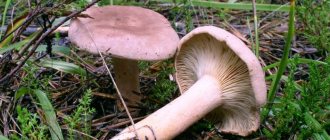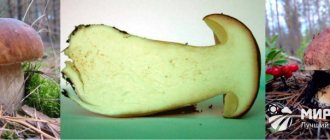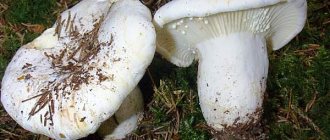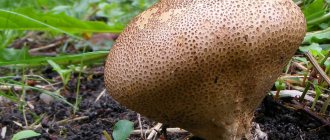Stolyarov Vasily Stepanovich
Expert in Silent Hunting
Paneolus blue. A huge number of quite specific resources on the Internet are devoted to hallucinogenic mushrooms growing in Russia, and here I will tell you what you really need to know about this kind of mushrooms. Despite the fact that psilocybin drug addicts are spreading information about the harmlessness of using such mushrooms with all their might, in no case should you conduct such experiments on your own psyche. The danger is not physical harm; it is actually negligible. But the person himself in the midst of such a drug trip poses a danger both to himself and to others. He simply finds himself in another reality, in which a loved one may seem like a mortal enemy who must be immediately destroyed, for example. You can well imagine the consequences... In addition, the use of this kind of hallucinogens can cause or complicate many mental diseases.
— Stolyarov Vasily Stepanovich Expert in silent hunting
Description
Paneolus blue.
hat
Small, only up to 4 cm in diameter. In young specimens, it has the shape of a hemisphere with an upward-curved edge; as it develops and grows, it acquires a bell-shaped, outstretched shape. The skin of the cap is dry, in young specimens it is colored light brown.
As the mushroom ripens, the cap gradually brightens, becoming almost white or grayish at the end of the life cycle; in rare cases, the brown color remains until the fruiting body is old. With low humidity and little precipitation, the cap cracks densely; if such cracks become deep enough, they acquire a blue or green tint.
Copelandia is abnormal.
Spore-bearing layer
Lamellar. In young mushrooms, the hymenophore is gray in color, sometimes with a reddish or brown tint. As the spore powder matures, the plates darken to black, retaining a white edge.
The arrangement of the plates is frequent, some adhere to the stem, others remain freely located. Black spore powder. The spores are also black, ellipsoidal, and smooth.
Leg
Blue dreams.
Cylindrical, regular shape. Long and thin, it reaches only 0.5 centimeters in thickness and up to 12 centimeters in height. Most often the leg is straight, less often it is slightly curved. There is a thickening at the base.
The surface is smooth, the structure is continuous, fibrous. Painted in gray, white with a pink or yellow tint. Turns blue when pressed.
Pulp
White or grayish, at the site of a break or cut it turns blue on the periphery, the center remains unchanged. The taste of the pulp is neutral, the aroma is pleasant, mealy.
Danger of use
The dung beetle is a mushroom that can play a cruel joke on the human consciousness. Under the influence of Paneolus bellflower, the senses begin to work more intensely and sharply. The bouts of laughter intensify, and everything around seems cheerful and funny. This effect occurs in several stages:
- First of all, vision and hearing are enhanced. Everything around takes on a more saturated color and sound. Some people experience slight memory impairment at this stage.
- Then the picture comes to life even more, and objects begin to move. The sense of time is disrupted, and creativity is enhanced.
- The next stage is the appearance of hallucinations. The real surrounding reality begins to mix with mirages.
- After hallucinations comes a feeling of fragmentation of a person as an individual. It may seem that the body does not belong to him, and he can possess inanimate objects.
- The final stage is absolute detachment from reality.
Particular caution should be exercised by people with emotional distress or mental illness. Eating such mushrooms can cause complications.
Important! The information presented in the material is for informational purposes only. Before use, be sure to consult a specialist.
Spreading
Copelandia is blue.
Paneolus blue is a cosmopolitan mushroom. It can be found both in temperate Europe and in tropical climates. The main condition for the growth of this fungus is the presence of manure, since it is a coprophage. Occasionally you can find single specimens, but most often Paneolus grows in groups, often quite large.
The period of active fruiting continues throughout the warm spring and summer-autumn seasons.
Paneolus bell-shaped.
Edibility
Paneolus bellflower is an inedible mushroom, and some sources claim that it is even poisonous. The pulp of the dung beetle's fruiting bodies is dangerous because it contains a significant amount of the toxic substance psilocybin, which has hallucinogenic properties. A small amount when ingested causes:
- inability to move;
- mild memory impairment;
- sharpening of perception;
- lack of relationship with the surrounding reality;
- moving objects;
- distortion of time perception.
Interesting Facts
Amanita blue.
Some types of hallucinogenic mushrooms, including blue paneolus, are still grown by South American Indian tribes and used for religious purposes. They consider the hallucinations caused by psilocybin to be revelations sent by the gods. The culture of eating these mushrooms is described in more detail by Carlos Castaneda.
List of species[ | ]
The genus Konocybe includes more than 200 species.
- Conocybe acutoconica Watling, 1977
- Conocybe affinis Singer, 1969
- Conocybe africana (Pegler) Watling, 1981
- Conocybe alachuana (Murrill) Hesler, 1981
- Conocybe ambigua Watling, 1980
- Conocybe antipus (Lasch) Fayod, 1889
- Conocybe apala (Fr.) Arnolds, 2003
- Conocybe atkinsonii Watling, 1981
- Conocybe aurea (Jul. Schäff.) Hongo, 1963
- Conocybe blattaria (Fr.) Kühner, 1935
- Conocybe brachypodii (Velen.) Hauskn. & Svrcek, 1999
- Conocybe bulbifera (Kauffman) Romagn., 1942
- Conocybe caespitosa (Murrill) Watling, 1977
- Conocybe candida (Cooke & Massee) Watling, 1977
- Conocybe capillaripes (Peck) Watling, 1977
- Conocybe crispa (Longyear) Singer, 1951
- Conocybe crispella (Murrill) Singer, 1950
- Conocybe curta (GF Atk.) Watling, 1981
- Conocybe deliquescens Hauskn. & Krisai, 2006
- Conocybe dennisii Hauskn., 2002
- Conocybe diemii Singer, 1969
- Conocybe digitalina (Velen.) Singer, 1989
- Conocybe discorosea E. Horak, Hauskn. & Desjardin, 2002
- Conocybe dumetorum (Velen.) Svrcek, 1956
- Conocybe dunensis T. J. Wallace, 1960
- Conocybe echinata (Velen.) Singer, 1989
- Conocybe farinacea Watling, 1964
- Conocybe fimetaria Watling, 1986
- Conocybe fiorii (D. Sacc.) Watling, 1981
- Conocybe fuscimarginata (Murrill) Singer, 1969
- Conocybe glabra (Murrill) Watling, 1977
- Conocybe gracilenta Watling & GM Taylor, 1987
- Conocybe graminis Hauskn., 1996
- Conocybe herbarum Hauskn., 1996
- Conocybe horakii Watling & GM Taylor, 1987
- Conocybe hornana Singer & Hauskn., 1989
- Conocybe incarnata (Jul. Schäff.) Hauskn. & Arnolds, 2003
- Conocybe inocybeoides Watling, 1980
- Conocybe intrusa (Peck) Singer, 1950
- Conocybe juniana (Velen.) Hauskn. & Svrcek, 1999
- Conocybe khasiensis (Berk.) Watling, 1981
- Conocybe lateritia (P. Kumm.) Kühner, 1935
- Conocybe lentispora Singer, 1950
- Conocybe leporina (Velen.) Singer, 1989
- Conocybe leucopus Kühner ex Kühner & Watling, 1983
- Conocybe locellina (Murrill) Watling, 1977
- Conocybe macrocephala Kühner & Watling, 1980
- Conocybe macrospora (GF Atk.) Hauskn., 2003
- Conocybe magnispora (Murrill) Singer, 1950
- Conocybe merdaria Arnolds & Hauskn., 2003
- Conocybe mesospora Kühner ex Watling, 1980
- Conocybe mexicana (Murrill) Watling, 1981
- Conocybe microrrhiza Hauskn., 1999
- Conocybe microspora (Velen.) Dennis, 1953
- Conocybe moseri Watling, 1980
- Conocybe myosura Singer, 1989
- Conocybe neoantipus (GF Atk.) Singer, 1936
- Conocybe nivea (Massee) Watling, 1981
- Conocybe ochracea Kühner ex Singer, 1959
- Conocybe pallidospora Kühner & Watling, 1983
- Conocybe pilosella (Pers.) Kühner, 1935
- Conocybe plicatella (Peck) Kühner, 1935
- Conocybe pragensis Hauskn., 1999
- Conocybe pubescens (Gillet) Kühner, 1935
- Conocybe pulchella (Velen.) Hauskn. & Svrcek, 1999
- Conocybe pulchra (Clem.) Hauskn., Krisai & Voglmayr, 2004
- Conocybe reticulata (Peck) Watling, 1977
- Conocybe rostellata (Velen.) Hauskn. & Svrcek, 1999
- Conocybe sabulicola Hauskn. & Enderle, 1992
- Conocybe semiglobata Kühner ex Singer, 1959
- Conocybe siennophylla (Berk. & Broome) Singer, 1955
- Conocybe siliginea (Fr.) Kühner, 1935
- Conocybe siligineoides R.Heim, 1957
- Conocybe spicula (Lasch) Kühner, 1935
- Conocybe spiculoides Kühner ex Singer, 1959
- Conocybe stictospora Singer, 1989
- Conocybe subcrispa (Murrill) Singer, 1950
- Conocybe subovalis Kühner & Watling, 1980
- Conocybe sulcatipes (Peck) Kühner, 1935
- Conocybe tenera (Schaeff.) Fayod, 1889
- Conocybe tetraspora Singer, 1969
- Conocybe tortipes (Murrill) Watling, 1981
- Conocybe tuxtlaensis Singer, 1989
- Conocybe umbonata (Massee) Watling, 1966
- Conocybe velutipes (Velen.) Hauskn. & Svrcek, 1999
- Conocybe vinaceobrunnea Hauskn., 2002
- Conocybe volviornata E. Horak, Hauskn. & Desjardin, 2002
- Conocybe watlingii Hauskn., 1996
- Conocybe xylophila Singer, 1969
Spores of asexual reproduction of Lycogales woody
Now myxomycetes occupy a separate place in science. Mushrooms are more related to living organisms, since they are very similar to them in their feeding method. However, wolf's milk reproduces in a very interesting way. During the ripening period, small warts appear on the shell, a hole opens in them, through which spores begin to spread.
The fungus begins to reproduce when it senses that the nutrients in its habitat are running low. To continue their existence, spores are actively released, which, unlike other families, are extremely mobile (considered living microorganisms - amoebas). Balls on stumps and wood are just an intermediate form that hardens in the sun and begins to accumulate spore fluid for distribution.
When it completely hardens inside the ball, the latter will begin to collapse. Plasmodium, which has a nucleus and protoplasm, will actively emerge from the holes. The cells grow and divide very quickly; after just a few days they settle on a healthy body and continue to feed.
Hallucinogenicity
What else is worth mentioning when talking about Paneolus?
Of course, about the hallucinogenicity of these mushrooms.
Indeed, we can talk for a long time about the hallucinogenic properties of Paneolus fringe. The fact is that even after preliminary boiling, these mushrooms still leave some effect in the body. Depending on the geographic zone in which a given mushroom grows, its composition of psychedelic substances can vary significantly. For example, a substance such as psilocin was found in the composition of Paneolus fringe in Russia, however, in the population that was discovered in Hawaii this percentage is much higher. But in mushrooms that grow in North America, the amount contained in strength and the price are much lower.
In addition, the composition of this mushroom includes: serotonin, tryptamine, beocystin and tryptophan. All these substances together have a destructive effect on the psyche if paneolus is taken frequently and in large quantities.
Today, the maximum permissible dose of dried mushrooms for humans is 2 g, fresh - 10 g. Only in this case can the negative effect and impact on the body be avoided.
Paneolus fringe, of course, is a type of mushroom that does not leave anyone indifferent. These small forest inhabitants are very beautiful, so every tourist considers it his duty to photograph them. However, remember that hidden danger awaits you. Paneolus fringe is a very insidious mushroom, which in most cases can lead to poisoning and other undesirable consequences. Therefore, these forest dwellers should only admire it, but under no circumstances touch it with your hands, much less collect it in your basket. Experiments with boiling and subsequent processing of mushrooms are best left to fans of extreme cuisine.
Signs of poisoning and first aid
It is almost impossible to find out about mushroom poisoning. The spores penetrate the respiratory tract and then begin to develop inside the body. Today there are a number of diseases that wolf's milk can cause: cancer, endocarditis, arthritis.
It will be quite difficult to purposefully eat a mushroom, since at the slightest touch it will begin to spread. If this can be done, then after a short period of time indigestion will appear, and then intestinal infectious diseases.
The attending physician should know that the patient has had contact with this plant. Only in this case can a correct diagnosis be made in time.
